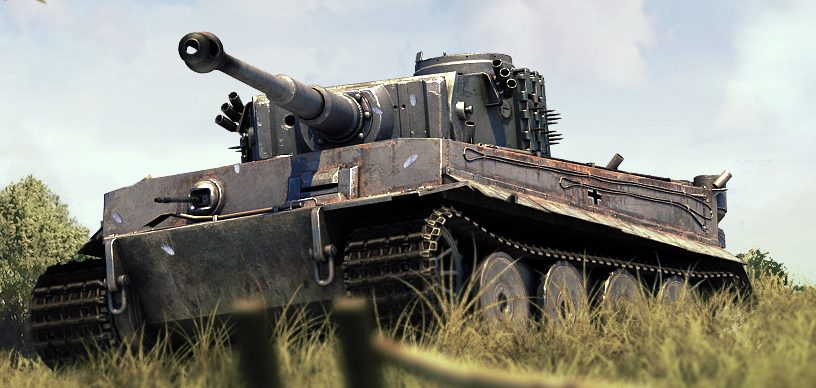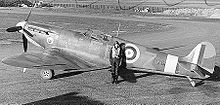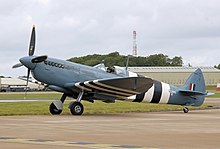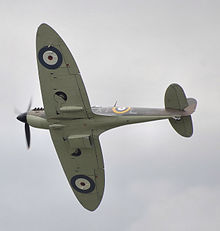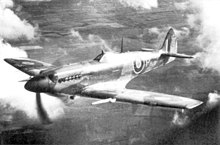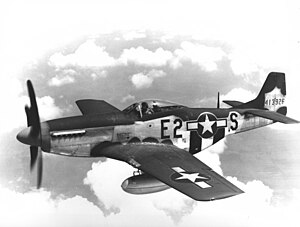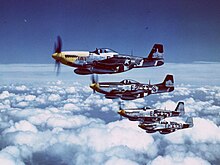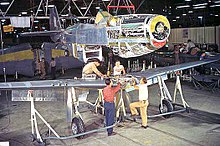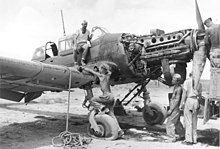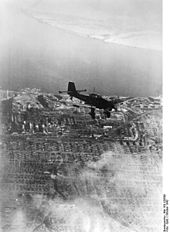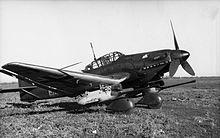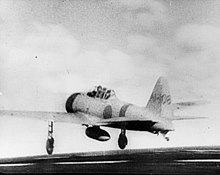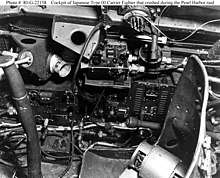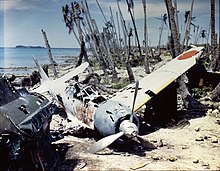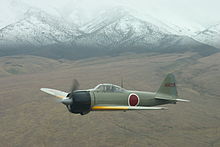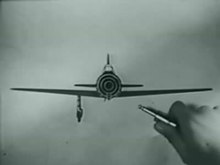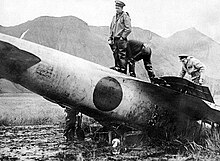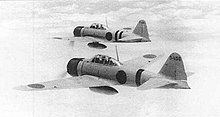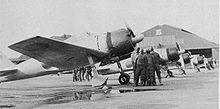Supermarine Spitfire
| Spitfire | |
|---|---|
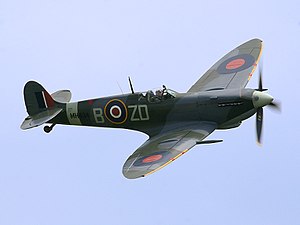 |
|
| Spitfire LF Mk IX, MH434 being flown by Ray Hanna in 2005. This aircraft shot down a Focke-Wulf Fw 190 in 1943 while serving with No. 222 Squadron RAF. | |
| Role | Fighter / Photo-reconnaissanceaircraft |
| National origin | United Kingdom |
| Manufacturer | Supermarine |
| Designer | R. J. Mitchell |
| First flight | 5 March 1936[1] |
| Introduction | 4 August 1938[1] |
| Retired | 1961 Irish Air Corps[2] |
| Primary users | Royal Air Force |
| Produced | 1938–1948 |
| Number built | 20,351[3] |
| Unit cost | |
| Variants | |
Audio recording of Spitfire fly past at the 2011 family day at RAF Halton, Buckinghamshire
The Supermarine Spitfire is a British single-seat fighter aircraft used by the Royal Air Force and other Allied countries before, during and after World War II. Many variants of the Spitfire were built, using several wing configurations, and it was produced in greater numbers than any other British aircraft. It was also the only British fighter produced continuously throughout the war. The Spitfire continues to be popular among enthusiasts; about 54 remain airworthy, and many more are static exhibits in aviation museums throughout the world.
The Spitfire was designed as a short-range, high-performance interceptor aircraft by R. J. Mitchell, chief designer at Supermarine Aviation Works, which operated as a subsidiary of Vickers-Armstrong from 1928. Mitchell pushed the Spitfire’s distinctive elliptical wing designed by Beverley Shenstone[citation needed] to have the thinnest possible cross-section, helping give the aircraft a higher top speed than several contemporary fighters, including the Hawker Hurricane. Mitchell continued to refine the design until his death in 1937, whereupon his colleague Joseph Smith took over as chief designer, overseeing the Spitfire’s development through its multitude of variants.
During the Battle of Britain, from July to October 1940, the public perceived the Spitfire to be the main RAF fighter, though the more numerous Hurricane shouldered a greater proportion of the burden against Nazi Germany‘s air force, the Luftwaffe. However, Spitfire units had a lower attrition rate and a higher victory-to-loss ratio than those flying Hurricanes because of the Spitfire’s higher performance. During the Battle, Spitfires were generally tasked with engaging Luftwaffe fighters—mainly Messerschmitt Bf 109E series aircraft—which were a close match for them.
After the Battle of Britain, the Spitfire superseded the Hurricane to become the backbone of RAF Fighter Command, and saw action in the European, Mediterranean, Pacific, and South-East Asian theatres. Much loved by its pilots, the Spitfire served in several roles, including interceptor, photo-reconnaissance, fighter-bomber and trainer, and it continued to serve in these roles until the 1950s. The Seafire was a carrier-based adaptation of the Spitfire which served in the Fleet Air Arm from 1942 through to the mid-1950s. Although the original airframe was designed to be powered by a Rolls-Royce Merlin engine producing 1,030 hp(768 kW), it was strong enough and adaptable enough to use increasingly powerful Merlins and, in later marks, Rolls-Royce Griffon engines producing up to 2,340 hp (1,745 kW). As a result, the Spitfire’s performance and capabilities improved over the course of its service life.
Development and production
Origins
In 1931 the Air Ministry released specification F7/30, calling for a modern fighter capable of a flying speed of 250 mph (400 km/h). R. J. Mitchell designed the Supermarine Type 224to fill this role. The 224 was an open-cockpit monoplane with bulky gull-wings and a large, fixed, spatted undercarriage powered by the 600 horsepower (450 kW), evaporatively cooled Rolls-Royce Goshawk engine.[5] It made its first flight in February 1934.[6] Of the seven designs tendered to F7/30, the Gloster Gladiator biplane was accepted for service.[7]
The Type 224 was a big disappointment to Mitchell and his design team, who immediately embarked on a series of “cleaned-up” designs, using their experience with the Schneider Trophy seaplanes as a starting point.[7] This led to the Type 300, with retractable undercarriage and a wingspan reduced by 6 ft (1.8 m). This design was submitted to the Air Ministry in July 1934, but was not accepted.[8] It then went through a series of changes, including the incorporation of a faired, enclosed cockpit, oxygen-breathing apparatus, smaller and thinner wings, and the newly developed, more powerful Rolls-Royce PV-XII V-12 engine, later named the “Merlin”. In November 1934, Mitchell, with the backing of Supermarine‘s owner Vickers-Armstrong, started detailed design work on this refined version of the Type 300.[9]
On 1 December 1934, the Air Ministry issued contract AM 361140/34, providing £10,000 for the construction of Mitchell’s improved Type 300, design.[10] On 3 January 1935, they formalised the contract with a new specification, F10/35, written around the aircraft.[11] In April 1935, the armament was changed from two .303 in (7.7 mm) Vickers machine guns in each wing to four .303 in (7.7 mm) Brownings,[12] following a recommendation by Squadron Leader Ralph Sorley of the Operational Requirements section at the Air Ministry.[13]
On 5 March 1936,[14][nb 2] the prototype (K5054) took off on its first flight from Eastleigh Aerodrome (later Southampton Airport). At the controls was Captain Joseph “Mutt” Summers, chief test pilot for Vickers, who is quoted as saying “Don’t touch anything” on landing.[15][nb 3] This eight-minute flight[13] came four months after the maiden flight of the contemporary Hurricane.[17]
K5054 was fitted with a new propeller, and Summers flew the aircraft on 10 March 1936; during this flight the undercarriage was retracted for the first time.[18] After the fourth flight, a new engine was fitted, and Summers left the test-flying to his assistants, Jeffrey Quill and George Pickering. They soon discovered that the Spitfire[nb 4][21] was a very good aircraft, but not perfect. The rudder was oversensitive, and the top speed was just 330 mph (528 km/h), little faster than Sydney Camm‘s new Merlin-powered Hurricane.[23] A new and better-shaped wooden propeller allowed the Spitfire to reach 348 mph (557 km/h) in level flight in mid-May, when Summers flew K5054 to RAF Martlesham Heath and handed the aircraft over to Squadron Leader Anderson of the Aeroplane & Armament Experimental Establishment (A&AEE). Here, Flight Lieutenant Humphrey Edwardes-Jones took over the prototype for the RAF.[24] He had been given orders to fly the aircraft and then to make his report to the Air Ministry on landing. Edwardes-Jones’ report was positive; his only request was that the Spitfire be equipped with an undercarriage position indicator.[25] A week later, on 3 June 1936, the Air Ministry placed an order for 310 Spitfires,[26] before the A&AEE had issued any formal report. Interim reports were later issued on a piecemeal basis.[27]
Initial production
The British public first saw the Spitfire at the RAF Hendon air-display on Saturday 27 June 1936. Although full-scale production was supposed to begin immediately, there were numerous problems that could not be overcome for some time, and the first production Spitfire, K9787, did not roll off the Woolston, Southampton assembly line until mid-1938.[1]
In February 1936, the director of Vickers-Armstrong, Sir Robert MacLean, guaranteed production of five aircraft a week, beginning 15 months after an order was placed. On 3 June 1936, the Air Ministry placed an order for 310 aircraft, at a cost of £1,395,000.[28] Full-scale production of the Spitfire began at Supermarine’s facility in Woolston, but it quickly became clear that the order could not be completed in the 15 months promised. Supermarine was a small company, already busy building Walrus and Stranraer flying boats, and Vickers was busy building Wellington bombers.
The initial solution was to subcontract the work.[28] Although outside contractors were supposed to be involved in manufacturing many important Spitfire components, especially the wings, Vickers-Armstrong (the parent company) was reluctant to see the Spitfire being manufactured by outside concerns, and was slow to release the necessary blueprints and subcomponents.[29]
As a result of the delays in getting the Spitfire into full production, the Air Ministry put forward a plan that its production be stopped after the initial order for 310, after which Supermarine would build Bristol Beaufighters. The managements of Supermarine and Vickers were able to convince the Air Ministry that production problems could be overcome, and a further order was placed for 200 Spitfires on 24 March 1938. The two orders covered the K, L and N prefix serial numbers.[29]
In mid-1938, the first production Spitfire rolled off the assembly line[1] and was flown by Jeffrey Quill on 15 May 1938, almost 24 months after the initial order.[30] The final cost of the first 310 aircraft, after delays and increased programme costs, came to £1,870,242 or £1,533 more per aircraft than originally estimated.[4] A production aircraft cost about £9,500. The most expensive components were the hand-fabricated and finished fuselage at approximately £2,500, then the Rolls-Royce Merlin engine at £2,000, followed by the wings at £1,800 a pair, guns and undercarriage, both at £800 each, and the propeller at £350.[31]
Manufacturing at Castle Bromwich, Birmingham
Spitfire Mk IIA, P7666, EB-Z, “Observer Corps”, was built at Castle Bromwich, and delivered to 41 Squadron on 23 November 1940.[nb 5]
In 1935, the Air Ministry approached Morris Motors Limited to ask how quickly their Cowley plant could be turned to aircraft production. In 1936 this informal request for major manufacturing facilities was turned into a formal scheme, known as the shadow factory plan, to boost British aircraft production capacity under the leadership of Herbert Austin. He was given the task of building nine new factories, and to supplement the existing British car manufacturing industry by either adding to overall capacity or increasing the potential for reorganisation to produce aircraft and their engines.[32]
In 1938, construction began on the Castle Bromwich Aircraft Factory (CBAF), next to the aerodrome, and the installation of the most modern machine tools then available began two months after work started on the site.[4] Although Morris Motors, under Lord Nuffield (an expert in mass motor-vehicle construction), managed and equipped the factory, it was funded by government money. By the beginning of 1939 the factory’s original, estimated cost of £2,000,000 had more than doubled,[33] and even as the first Spitfires were being built in June 1940, the factory was still incomplete, and suffered from personnel problems. The Spitfire’s stressed-skin construction required precision engineering skills and techniques that were beyond the capabilities of the local labour force, and it required some time to re-train them. There were problems with management, who ignored Supermarine’s tooling and drawings in favour of their own, and the workforce continually threatened strikes or “slow downs” until their demands for higher wages were met.[34]
In spite of promises the factory would be producing 60 per week starting in April, by May 1940 Castle Bromwich had not yet built its first Spitfire.[33] On 17 May, Minister of Aircraft Production Lord Beaverbrook telephoned Lord Nuffield and manoeuvred him into handing over control of the Castle Bromwich plant to his Ministry.[35] Beaverbrook immediately sent in experienced management staff and workers from Supermarine and gave control of the factory to Vickers-Armstrong. Although it would take some time to resolve the problems, in June 1940, 10 Mk IIs were built; 23 rolled out in July, 37 in August, and 56 in September.[36] By the time production ended at Castle Bromwich in June 1945, a total of 12,129 Spitfires (921 Mk IIs,[37] 4,489 Mk Vs, 5,665 Mk IXs,[38] and 1,054 Mk XVIs[37]) had been built. CBAF went on to become the largest and most successful plant of its type during the 1939–45 conflict. As the largest Spitfire factory in the UK, by producing a maximum of 320 aircraft per month, it built 12,000 aircraft of this type, before its closure in 1945.[39]
Production dispersal
This Spitfire PR Mk XI (PL965) was built at RAF Aldermaston in southern England.
During the Battle of Britain, the Luftwaffe made concerted efforts to destroy the main manufacturing plants at Woolston and Itchen, near Southampton. The first bombing raid, which missed the factories, came on 23 August 1940. Over the next month, other raids were mounted until, on 26 September 1940, both factories were destroyed,[40] with 92 people killed and a large number injured. Most of the casualties were experienced aircraft production workers.[41]
Fortunately for the future of the Spitfire, many of the production jigs and machine tools had already been relocated by 20 September, and steps were being taken to disperse production to small facilities throughout the Southampton area.[40] To this end, the British government requisitioned the likes of Vincent’s Garage in Station Square, Reading, which later specialised in manufacturing Spitfire fuselages, and Anna Valley Motors, Salisbury, which was to become the sole producer of the wing leading-edge fuel tanks for photo-reconnaissance Spitfires, as well as producing other components.
A purpose-built works, specialising in manufacturing fuselages and installing engines, was built at Star Road, Caversham in Reading.[41] The drawing office in which all Spitfire designs were drafted was relocated to Hursley Park, near Southampton. This site also had an aircraft assembly hangar where many prototype and experimental Spitfires were assembled, but since it had no associated aerodrome no Spitfires ever flew from Hursley.
Four towns and their satellite airfields were chosen to be the focal points for these workshops:[40] Southampton’s Eastleigh Airport; Salisbury’s High Post and Chattis Hill aerodromes;[nb 6] Trowbridge‘s Keevil aerodrome;[42] and Reading’s Henley and Aldermaston aerodromes.
An experimental factory at Newbury was the subject of a Luftwaffe daylight raid, but the bombs missed their target and hit a nearby school.
Completed Spitfires were delivered to the airfields on large Commer “Queen Mary” low-loader articulated lorries (trucks), there to be fully assembled, tested, then passed on to the RAF.[41]
Flight testing
All production aircraft were flight tested before delivery. During the Second World War, Jeffrey Quill was Vickers Supermarine’s chief test pilot, in charge of flight-testing all aircraft types built by Vickers Supermarine. He oversaw a group of 10 to 12 pilots responsible for testing all developmental and production Spitfires built by the company in the Southampton area.[nb 7] Quill devised the standard testing procedures which, with variations for specific aircraft designs, operated from 1938.[43][44] Alex Henshaw, chief test pilot at Castle Bromwich from 1940, was placed in charge of testing all Spitfires built at that factory. He co-ordinated a team of 25 pilots and assessed all Spitfire developments. Between 1940 and 1946, Henshaw flew a total of 2,360 Spitfires and Seafires, more than 10% of total production.[45][46]
Henshaw wrote about flight testing Spitfires:
After a thorough pre-flight check I would take off and, once at circuit height, I would trim the aircraft and try to get her to fly straight and level with hands off the stick … Once the trim was satisfactory I would take the Spitfire up in a full-throttle climb at 2,850 rpm to the rated altitude of one or both supercharger blowers. Then I would make a careful check of the power output from the engine, calibrated for height and temperature … If all appeared satisfactory I would then put her into a dive at full power and 3,000 rpm, and trim her to fly hands and feet off at 460 mph (740 km/h) IAS (Indicated Air Speed). Personally, I never cleared a Spitfire unless I had carried out a few aerobatic tests to determine how good or bad she was.
The production test was usually quite a brisk affair: the initial circuit lasted less than ten minutes and the main flight took between twenty and thirty minutes. Then the aircraft received a final once-over by our ground mechanics, any faults were rectified and the Spitfire was ready for collection.
I loved the Spitfire in all of her many versions. But I have to admit that the later marks, although they were faster than the earlier ones, were also much heavier and so did not handle so well. You did not have such positive control over them. One test of manoeuvrability was to throw her into a flick-roll and see how many times she rolled. With the Mark II or the Mark V one got two-and-a-half flick-rolls but the Mark IX was heavier and you got only one-and-a-half. With the later and still heavier versions, one got even less. The essence of aircraft design is compromise, and an improvement at one end of the performance envelope is rarely achieved without a deterioration somewhere else.[47][48]
When the last Spitfire rolled out in February 1948,[49] a total of 20,351 examples of all variants had been built, including two-seat trainers, with some Spitfires remaining in service well into the 1950s.[3] The Spitfire was the only British fighter aircraft to be in continuous production before, during and after the Second World War.[50]
Design
Airframe
Spitfire Mk IIa P7350 of the BBMFis the only existing airworthy Spitfire that fought in the Battle of Britain.
In the mid-1930s, aviation design teams worldwide began developing a new generation fighter aircraft. The French Dewoitine D.520[51] and the German Messerschmitt Bf 109, for example, were designed to take advantage of new techniques of monocoque construction, and the availability of new, high-powered, liquid-cooled, in-line aero engines. They also featured refinements such as retractable undercarriages, fully enclosed cockpits, and low drag, all-metal wings. These advances had been introduced on civil airliners years before, but were slow to be adopted by the military, who favoured the biplane’s simplicity and manoeuvrability.[52]
Mitchell’s design aims were to create a well-balanced, high-performance fighter aircraft capable of fully exploiting the power of the Merlin engine, while being relatively easy to fly.[53] At the time, with France as an ally, and Germany thought to be the most likely future opponent, no enemy fighters were expected to appear over Great Britain. German bombers would have to fly to the UK over the North Sea, and Germany did not have any single-engine fighters with the range to accompany them. To carry out the mission of home defence, the design was intended to allow the Spitfire to climb quickly to intercept enemy bombers.[54]
The Spitfire’s airframe was complex. The streamlined, semi-monocoque, duralumin-skinned fuselage featured a number of compound, vertical curves built up from a skeleton of 19 formers, also known as frames, starting from frame number one, immediately behind the propeller unit, to the tail unit attachment frame. The first four frames supported the glycol header tank and engine cowlings. Frame five, to which the engine bearers were secured, supported the weight of the engine and its accessories. This was a strengthened double frame which also incorporated the fireproof bulkhead and, in later versions of the Spitfire, the oil tank. This frame also tied the four main fuselage longerons to the rest of the airframe.[55]Behind the bulkhead were five ‘U’ shaped half-frames which accommodated the fuel tanks and cockpit. The rear fuselage started at the eleventh frame, to which the pilot’s seat and (later) armour plating was attached, and ended at the nineteenth, which was mounted at a slight forward angle just forward of the fin. Each of these nine frames was oval, reducing in size towards the tail, and incorporated several lightening holes to reduce their weight as much as possible without weakening them. The U-shaped frame 20 was the last frame of the fuselage proper and the frame to which the tail unit was attached. Frames 21, 22 and 23 formed the fin; frame 22 incorporated the tailwheel opening and frame 23 was the rudderpost. Before being attached to the main fuselage, the tail unit frames were held in a jig and the eight horizontal tail formers were riveted to them.[56]
A combination of 14 longitudinal stringers and four main longerons attached to the frames helped form a light, but rigid structure to which sheets of alclad stressed skinning were attached. The fuselage plating was 24, 20 and 18 gauge in order of thickness towards the tail, while the fin structure was completed using short longerons from frames 20 to 23, before being covered in 22 gauge plating.[57]
The skins of the fuselage, wings and tailplane were secured by dome-headed rivets, and in critical areas such as the wing forward of the main spar where an uninterrupted airflow was required, with flush rivets. From February 1943 flush riveting was used on the fuselage, affecting all Spitfire variants.[58] In some areas, such as at the rear of the wing, and the lower tailplane skins, the top was riveted and the bottom fixed by brass screws which tapped into strips of spruce bolted to the lower ribs. The removable wing tips were made up of duralumin-skinned spruce formers.[59] At first the ailerons, elevators and rudder were fabric-covered, but combat experience showed that fabric-covered ailerons were impossible to use at high speeds, a light alloy replaced the fabric, enhancing control throughout the speed range.[60]
Elliptical wing design
In 1934, Mitchell and the design staff decided to use a semi-elliptical wing shape to solve two conflicting requirements; the wing needed to be thin to avoid creating too much drag, but it had to be thick enough to house the retractable undercarriage, armament and ammunition. An elliptical planform is the most efficient aerodynamic shape for an untwisted wing, leading to the lowest amount of induced drag. The ellipse was skewed so that the centre of pressure, which occurs at the quarter-chord position, aligned with the main spar, preventing the wings from twisting. Mitchell has sometimes been accused of copying the wing shape of the Heinkel He 70, which first flew in 1932, but as Beverley Shenstone, the aerodynamicist on Mitchell’s team, explained: “Our wing was much thinner and had quite a different section to that of the Heinkel. In any case it would have been simply asking for trouble to have copied a wing shape from an aircraft designed for an entirely different purpose.”[61][nb 8]
Beverly Shenstone[62]
The wing section used was from the NACA 2200 series, which had been adapted to create a thickness-to-chord ratio of 13% at the root, reducing to 9.4% at the tip.[63] A dihedral of six degrees was adopted to give increased lateral stability.[53]
A wing feature, which contributed greatly to its success, was an innovative spar boom design, made up of five square tubes that fitted into each other. As the wing thinned out along its span, the tubes were progressively cut away in a similar fashion to a leaf spring; two of these booms were linked together by an alloy web, creating a lightweight and very strong main spar.[64] The undercarriage legs were attached to pivot points built into the inner, rear section of the main spar, and retracted outwards and slightly backwards into wells in the non-load-carrying wing structure. The resultant narrow undercarriage track was considered an acceptable compromise as this reduced the bending loads on the main-spar during landing.[64]
Ahead of the spar, the thick-skinned leading edge of the wing formed a strong and rigid D-shaped box, which took most of the wing loads. At the time the wing was designed, this D-shaped leading edge was intended to house steam condensers for the evaporative cooling system intended for the PV-XII. Constant problems with the evaporative system in the Goshawk led to the adoption of a cooling system which used 100% glycol.[nb 9] The radiators were housed in a new radiator-duct designed by Fredrick Meredith of the Royal Aircraft Establishment (RAE) at Farnborough, Hampshire. This used the cooling air to generate thrust, greatly reducing the net drag produced by the radiators.[65] In turn, the leading-edge structure lost its function as a condenser, but it was later adapted to house integral fuel tanks of various sizes[66]— a feature patented by Vickers-Supermarine in 1938.[67] The airflow through the main radiator was controlled by pneumatic exit flaps. In early marks of Spitfire (Mk I to Mk VI) the single flap was operated manually using a lever to the left of the pilot’s seat. When the two-stage Merlin was introduced in the Spitfire Mk IX the radiators were split to make room for an intercooler radiator; the radiator under the starboard wing was halved in size and the intercooler radiator housed alongside. Under the port wing a new radiator fairing housed a square oil cooler alongside of the other half-radiator unit. The two radiator flaps were now operated automatically via a thermostat.[68]
The elliptical planform of a Spitfire PR.Mk.XIX displayed at an air show in 2008. The black and white Invasion stripes are visible.
Another wing feature was its washout. The trailing edge of the wing twisted slightly upward along its span, the angle of incidence decreasing from +2° at its root to -½° at its tip.[69] This caused the wing roots to stall before the tips, reducing tip-stall that could otherwise have resulted in a wing drop, often leading to a spin. As the wing roots started to stall, the separating air stream started to buffet (vibrate) the aircraft, warning the pilot, allowing even relatively inexperienced pilots to fly it to the limits of its performance.[70] This washout was first featured in the wing of the Type 224, and became a consistent feature in subsequent designs leading to the Spitfire.[71] The complex wing design, especially the precision required to manufacture the vital spar and leading-edge structures, caused some major delays in the production of the Spitfire at first. The problems increased when the work was put out to subcontractors, most of whom had never dealt with metal-structured, high-speed aircraft. By June 1939, most of these problems had been resolved, and production was no longer held up by a lack of wings.[72]
All the main flight controls were originally metal structures with fabric covering.[nb 10] Designers and pilots felt that having ailerons which required a degree of effort to move at high speed would avoid unintended aileron reversal, throwing the aircraft around and potentially pulling the wings off. It was also felt that air combat would take place at relatively low speeds and that high-speed manoeuvring would be physically impossible. Flight tests showed the fabric covering of the ailerons “ballooned” at high speeds, adversely affecting the aerodynamics. Replacing the fabric covering with light alloy dramatically improved the ailerons at high speed.[74][75] During the Battle of Britain, pilots found the Spitfire’s ailerons were far too heavy at high speeds, severely restricting lateral manoeuvres such as rolls and high-speed turns, which were still a feature of air-to-air combat.[76]
The Spitfire had detachable wing tips which were secured by two mounting points at the end of each main wing assembly. When the Spitfire took on a role as a high-altitude fighter (Marks VI and VII and some early Mk VIIIs) the standard wing tips were replaced by extended, “pointed” tips which increased the wingspan from 36 ft 10 in (11.23 m) to 40 ft 2 in (12.24 m).[77] The other wing tip variation, used by several Spitfire variants, was the “clipped” wing; the standard wing tips were replaced by wooden fairings which reduced the span by 3 ft 6 in (1.07 m).[78] The wing tips used spruce formers for most of the internal structure with a light alloy skin attached using brass screws.[79]
The light alloy split flaps at the trailing edge of the wing were also pneumatically operated via a finger lever on the instrument panel.[80] Only two positions were available; fully up or fully down (85°). Flaps were normally lowered only during the final approach and for landing, and the pilot was to retract them before taxiing.[nb 11][81]
The ellipse also served as the design basis for the Spitfire’s fin and tailplane assembly, once again exploiting the shape’s favourable aerodynamic characteristics. Both the elevators and rudder were shaped so that their centre of mass was shifted forward, reducing control-surface flutter. The longer noses and greater propeller-wash resulting from larger engines in later models necessitated increasingly larger vertical and, later, horizontal tail surfaces to compensate for the altered aerodynamics, culminating in those of the Mk 22/24 series which were 25% larger in area than those of the Mk I.[82][83]
Improved late wing designs
As the Spitfire gained more power and was able to manoeuvre at higher speeds, the possibility that pilots would encounter aileron reversal increased, and the Supermarine design team set about redesigning the wings to counter this. The original wing design had a theoretical aileron reversal speed of 580 mph (930 km/h),[84] which was somewhat lower than that of some contemporary fighters. The Royal Aircraft Establishment noted that, at 400 mph (640 km/h) Indicated airspeed (IAS), roughly 65% of aileron effectiveness was lost due to wing twist.[85]
The new wing of the Spitfire F Mk 21 and its successors was designed to help alleviate this problem. Its stiffness was increased by 47%, and a new aileron design using piano hingesand geared trim tabs meant the theoretical aileron reversal speed was increased to 825 mph (1,328 km/h).[84][86][87] Alongside the redesigned wing, Supermarine also experimented with the original wing, raising the leading edge by one inch (2.54 cm), with the hope of improving pilot view and reducing drag. This wing was tested on a modified F Mk 21, also called the F Mk 23, (sometimes referred to as “Valiant” rather than “Spitfire”). The increase in performance was minimal and this experiment was abandoned.[88]
Supermarine developed a new laminar flow wing based on new aerofoil profiles developed by the National Advisory Committee for Aeronautics (NACA) in the United States, with the objective of reducing drag and improving performance. These laminar flow airfoils were the Supermarine 371-I used at the root and the 371-II used at the tip.[89] Supermarine estimated that the new wing could give an increase in speed of 55 mph (89 km/h) over the Spitfire Mk 21.[90] The new wing was initially fitted to a Spitfire Mk XIV. Later, a new fuselage was designed, with the new fighter becoming the Supermarine Spiteful.[91]
Carburetion versus fuel injection
Early in its development, the Merlin engine’s lack of fuel injection meant that Spitfires and Hurricanes, unlike the Bf 109E, were unable to simply nose down into a steep dive. This meant a Luftwaffe fighter could simply “bunt” into a high-power dive to escape an attack, leaving the Spitfire behind, as its fuel was forced out of the carburettor by negative “g”. RAF fighter pilots soon learned to “half-roll” their aircraft before diving to pursue their opponents.[92] Sir Stanley Hooker explained the carburettor was adopted because it “increased the performance of the supercharger and thereby increased the power of the engine”.[93][nb 12]
In March 1941, a metal disc with a hole was fitted in the fuel line, restricting fuel flow to the maximum the engine could consume. While it did not cure the problem of the initial fuel starvation in a dive, it did reduce the more serious problem of the carburettor being flooded with fuel by the fuel pumps under negative “g”. Invented by Beatrice “Tilly” Shilling, it became known as “Miss Shilling’s orifice“. Further improvements were introduced throughout the Merlin series, with Bendix-manufactured pressure carburettors, designed to allow fuel to flow during all flight attitudes, introduced in 1942.[93]
Armament[edit]
Due to a shortage of Brownings, which had been selected as the new standard rifle calibre machine gun for the RAF in 1934, early Spitfires were fitted with only four guns, with the other four fitted later.[95] Early tests showed that while the guns worked perfectly on the ground and at low altitudes, they tended to freeze at high altitude, especially the outer wing guns. This was because the RAF’s Brownings had been modified to fire from an open bolt. While this prevented overheating of the cordite used in British ammunition, it allowed cold air to flow through the barrel unhindered.[96] Supermarine did not fix the problem until October 1938, when they added hot air ducts from the rear of the wing-mounted radiators to the guns, and bulkheads around the gunbays to trap the hot air in the wing. Red fabric patches were doped over the gun ports to protect the guns from cold, dirt and moisture until they were fired.[97]
The decision on the arming of the Spitfire (and the Hurricane) is told in Captain C. H. Keith’s book I Hold my Aim. Keith held various appointments with the RAF dealing with designing, development and technical policy of armament equipment. He organised a conference, with Air Commodore Tedder in the chair, on 19 July 1934. He says “I think it can be reasonably contended that the deliberations of that conference made possible, if not certain, of the winning of the Battle of Britain, almost exactly six years later”.[98] At that meeting, scientific officer Captain F.W. ‘Gunner’ Hill presented charts based on his calculations showing that future fighters must carry no less than eight machine-guns, each of which must be capable of firing 1,000 shots a minute. Hill’s assistant in making his calculations had been his 14-year-old daughter.
Even if the eight Brownings worked perfectly, pilots soon discovered that they were not sufficient to destroy larger aircraft. Combat reports showed that an average of 4,500 rounds were needed to shoot down an enemy aircraft. In November 1938, tests against armoured and unarmoured targets had already indicated that the introduction of a weapon with a calibre of at least 20 mm was urgently needed.[99] A variant on the Spitfire design with four 20 mm Oerlikon cannon had been tendered to specification F37/35, but the order for prototypes had gone to the Westland Whirlwind in January 1939.[100]
In June 1939, a Spitfire was fitted with a drum-fed Hispano in each wing, an installation that required large blisters on the wing to cover the 60-round drum. The cannon suffered frequent stoppages, mostly because the guns were mounted on their sides to fit as much of the magazine as possible within the wing. In January 1940, P/O George Proudman flew this prototype in combat, but the starboard gun stopped after firing a single round, while the port gun fired 30 rounds before seizing.[97] If one cannon seized, the recoil of the other threw the aircraft off aim.
Nevertheless, 30 more cannon-armed Spitfires were ordered for operational trials, and they were soon known as the Mk IB, to distinguish them from the Browning-armed Mk IA; they were delivered to No. 19 Squadron beginning in June 1940. The Hispanos were found to be so unreliable that the squadron requested an exchange of its aircraft with the older Browning-armed aircraft of an operational training unit. By August, Supermarine had perfected a more reliable installation with an improved feed mechanism and four .303s in the outer wing panels. The modified fighters were then delivered to 19 Squadron.[97]
Operational history
Service operations
K9795, the 9th production Mk I, with 19 Squadron in 1938.
The operational history of the Spitfire with the RAF began with the first Mk Is K9789, which entered service with 19 Squadron at RAF Duxfordon 4 August 1938.[4][nb 13] The Spitfire achieved legendary status during the Battle of Britain, a reputation aided by the famous “Spitfire Fund” organised and run by Lord Beaverbrook, the Minister of Aircraft Production.[101]
In fact the Hurricane outnumbered the Spitfire throughout the battle, and shouldered the burden of the defence against the Luftwaffe; however, because of its higher performance the overall attrition rate of the Spitfire squadrons was lower than that of the Hurricane units, and the Spitfire units had a higher victory-to-loss ratio.[102]
The key aim of Fighter Command was to stop the Luftwaffe’s bombers; in practice, whenever possible, the tactic was to use Spitfires to counter German escort fighters, by then based in northern France, particularly the Bf 109s, while the Hurricane squadrons attacked the bombers.[103]
Well-known Spitfire pilots included “Johnnie” Johnson—34 enemy aircraft (e/a) shot down[104]—who flew the Spitfire right through his operational career from late 1940 to 1945. Douglas Bader (20 e/a) and “Bob” Tuck (27 e/a) flew Spitfires and Hurricanes during the major air battles of 1940. Both were shot down and became prisoners of war, while flying Spitfires over France in 1941 and 1942.[105] Paddy Finucane(28–32 e/a) scored all his successes in the fighter before disappearing over the English Channel in July 1942.[106] Some notable Commonwealth pilots were George Beurling (311⁄3 e/a) from Canada, “Sailor” Malan (27 e/a) from South Africa,[107] New Zealanders Alan Deere (17 e/a) and C F Gray (27 e/a)[108][109] and the Australian Hugo Armstrong (12 e/a).[110]
The Spitfire continued to play increasingly diverse roles throughout the Second World War and beyond, often in air forces other than the RAF. For example, the Spitfire became the first high-speed photo-reconnaissance aircraft to be operated by the RAF. Sometimes unarmed, they flew at high, medium and low altitudes, often ranging far into enemy territory to closely observe the Axis powers and provide an almost continual flow of valuable intelligence information throughout the war.
In 1941 and 1942, PRU Spitfires provided the first photographs of the Freya and Würzburg radar systems and, in 1943, helped confirm that the Germans were building the V1 and V2Vergeltungswaffe (“vengeance weapons”) rockets by photographing Peenemünde, on the Baltic Sea coast of Germany.[111]
In the Mediterranean the Spitfire blunted the heavy attacks on Malta by the Regia Aeronautica and Luftwaffe and, from early 1943, helped pave the way for the Allied invasions of Sicily and Italy. On 7 March 1942, 15 Mk Vs carrying 90-gallon fuel tanks under their bellies took off from HMS Eagle off the coast of Algeria on a 600-mile (970 km) flight to Malta.[112] Those Spitfire Vs were the first to see service outside Britain.[113]
The Spitfire also served on the Eastern Front: approximately a thousand were supplied to the Soviet Air Force. Though some were used at the frontline in 1943, most of them saw service with the Protivo-Vozdushnaya Oborona (English: “Anti-air Defence Branch”).[114]
The Spitfire also served in the Pacific Theatre where the Spitfire met its match in the Japanese Mitsubishi A6M Zero. Lt.Gen. Claire Lee Chennault noted: “The RAF pilots were trained in methods that were excellent against German and Italian equipment, but suicide against the acrobatic Japs.” [115] Although not as fast as the Spitfire, the Zero could out-turn the Spitfire with ease, could sustain a climb at a very steep angle, and could stay in the air for three times as long.[116] To counter the Zero, Spitfire pilots had to adopt a “slash and run” policy and use their faster speed and diving superiority to fight while avoiding classic dogfights.
It also did not help that Southeast Asia was a lower-priority area, which was allocated few Spitfires and other modern fighters compared to Europe, which allowed the Japanese to easily achieve air superiority by 1942.[117][118][119] Over the Northern Territory of Australia, Royal Australian Air Force (RAAF) and RAF Spitfires helped defend the port town of Darwin against air attack by the Japanese Naval Air Force,[120] suffering heavy losses largely due to the type’s limited fuel capacity.[121] Spitfire MKVIIIs took part in the last battle of World War II involving the Western allies in Burma, in the ground attack role, helping defeat a Japanese break-out attempt.[122]
During the Second World War, Spitfires were used by the United States Army Air Forces (USAAF) in the 4th Fighter Group until they were replaced by Republic P-47 Thunderbolts in March 1943.[123]
Several Spitfires were captured by the Germans and flown by units which tested, evaluated and sometimes clandestinely operated enemy aircraft.[124]
Speed and altitude records
Beginning in late 1943, high-speed diving trials were undertaken at Farnborough to investigate the handling characteristics of aircraft travelling at speeds near the sound barrier (i.e., the onset of compressibility effects). Because it had the highest limiting Mach number of any aircraft at that time, a Spitfire XI was chosen to take part in these trials. Due to the high altitudes necessary for these dives, a fully feathering Rotol propeller was fitted to prevent overspeeding. It was during these trials that EN409, flown by Squadron Leader J. R. Tobin, reached 606 mph (975 km/h) (Mach 0.891) in a 45° dive.
In April 1944, the same aircraft suffered engine failure in another dive while being flown by Squadron Leader Anthony F. Martindale, Royal Air Force Volunteer Reserve (RAFVR), when the propeller and reduction gear broke off. The dive put the aircraft to Mach 0.92, the fastest ever recorded in a piston-engined aircraft, but when the propeller came off the Spitfire, now tail-heavy, zoom-climbed back to altitude. Martindale blacked out under the 11 g loading, but when he resumed consciousness he found the aircraft at about 40,000 feet with its (originally straight) wings now slightly swept back.[125] Martindale successfully glided the Spitfire 20 mi (32 km) back to the airfield and landed safely.[126]Martindale was awarded the Air Force Cross for his exploits.[127]
RAE Bedford (RAE) modified a Spitfire for high-speed testing of the stabilator (then known as the “flying tail”) of the Miles M.52 supersonic research aircraft. RAE test pilot Eric Brown stated that he tested this successfully during October and November 1944, attaining Mach 0.86 in a dive.[128]
On 5 February 1952, a Spitfire 19 of 81 Squadron based at Kai Tak in Hong Kong reached probably the highest altitude ever achieved by a Spitfire. The pilot, Flight Lieutenant Edward Ted Cyril Powles,[129] was on a routine flight to survey outside-air temperature and report on other meteorological conditions at various altitudes in preparation for a proposed new air service through the area. He climbed to 50,000 ft (15,000 m) indicated altitude, with a true altitude of 51,550 ft (15,710 m). The cabin pressure fell below a safe level and, in trying to reduce altitude, he entered an uncontrollable dive which shook the aircraft violently. He eventually regained control somewhere below 3,000 ft (910 m) and landed safely with no discernible damage to his aircraft. Evaluation of the recorded flight data suggested he achieved a speed of 690 mph (1,110 km/h), (Mach 0.96) in the dive, which would have been the highest speed ever reached by a propeller-driven aircraft if the instruments had been considered more reliable.[126]
Jeffrey Quill[130]
The critical Mach number of the Spitfire’s original elliptical wing was higher than the subsequently used laminar-flow-section, straight-tapering-planform wing of the follow-on Supermarine Spiteful, Seafang and Attacker, illustrating that Reginald Mitchell’s practical engineering approach to the problems of high-speed flight had paid off.[131]
Variants
Overview
Although R. J. Mitchell is justifiably known as the engineer who designed the Spitfire, his premature death in 1937 meant that all development after that date was undertaken by a team led by his chief draughtsman, Joe Smith, who became Supermarine’s chief designer on Mitchell’s death. As Jeffrey Quill noted: “If Mitchell was born to design the Spitfire, Joe Smith was born to defend and develop it.”[132]
Pilots of 611 West LancashireSquadron pushing an early Spitfire Mark IXb at Biggin Hill in late 1942
There were 24 marks of Spitfire and many sub-variants. These covered the Spitfire in development from the Merlin to Griffon engines, the high-speed photo-reconnaissance variants and the different wing configurations. More Spitfire Mk Vs were built than any other type, with 6,487 built, followed by the 5,656 Mk IXs.[37] Different wings, featuring a variety of weapons, were fitted to most marks; the A wing used eight .303 in (7.7 mm) machine guns, the B wing had four .303 in (7.7 mm) machine guns and two 20 mm (.79 in) Hispano cannon, and the C, or universal, wing could mount either four 20 mm (.79 in) cannon or two 20 mm (.79 in) and four .303 in (7.7 mm) machine guns. As the war progressed, the C wing became more common.[133] Another armament variation was the E wing which housed two 20 mm (.79 in) cannon and two .50 in (12.7 mm) Browning machine guns.[134] Although the Spitfire continued to improve in speed and armament because of its limited fuel capacity its range and endurance were limited: it remained “short-legged” throughout its life except in the dedicated photo-reconnaissance role, when its guns were replaced by extra fuel tanks.[135]
Supermarine developed a two-seat variant known as the T Mk VIII to be used for training, but none were ordered, and only one example was ever constructed (identified as N32/G-AIDN by Supermarine).[136] In the absence of an official two-seater variant, a number of airframes were crudely converted in the field. These included a 4 Squadron SAAF Mk VB in North Africa, where a second seat was fitted instead of the upper fuel tank in front of the cockpit, although it was not a dual-control aircraft, and is thought to have been used as the squadron “run-about”.[137] The only unofficial two-seat conversions that were fitted with dual-controls were a few Russian lend/lease Mk IX aircraft. These were referred to as Mk IX UTI and differed from the Supermarine proposals by using an inline “greenhouse” style double canopy rather than the raised “bubble” type of the T Mk VIII.[137]
In the postwar era, the idea was revived by Supermarine and a number of two-seat Spitfires were built by converting old Mk IX airframes with a second “raised” cockpit featuring a bubble canopy. Ten of these TR9 variants were then sold to the Indian Air Force along with six to the Irish Air Corps, three to the Royal Netherlands Air Force and one for the Royal Egyptian Air Force.[136] Currently several of the trainers are known to exist, including both the T Mk VIII, a T Mk IX based in the US, and the “Grace Spitfire” ML407, a veteran flown operationally by 485(NZ) Squadron in 1944.[138][nb 14]
Seafire
Seafires preparing to take off from the aircraft carrier HMS Implacable in 1945
The Seafire, a name derived from sea, and Spitfire, was a naval version of the Spitfire specially adapted for operation from aircraft carriers. Although the Spitfire was not designed for the rough-and-tumble of carrier-deck operations, it was considered the best available fighter at the time. The basic Spitfire design did impose some limitations on the use of the aircraft as a carrier-based fighter; poor visibility over the nose, for example, meant that pilots had to be trained to land with their heads out of the cockpit and looking along the port cowling of their Seafire.[139] Like the Spitfire, the Seafire also had a relatively narrow undercarriage track, which meant that it was not ideally suited to deck operations.[140] Early Seafire marks had relatively few modifications to the standard Spitfire airframe; however cumulative front line experience meant that most of the later versions of the Seafire had strengthened airframes, folding wings, arrestor hooks and other modifications, culminating in the purpose-built Seafire F/FR Mk 47.[141]
The Seafire II was able to outperform the A6M5 Zero at low altitudes when the two types were tested against each other during wartime mock combat exercises.[142] However, contemporary Allied carrier fighters such as the F6F Hellcat and F4U Corsair were considerably more robust and so more practical for carrier operations.[143] Performance was greatly increased when later versions of the Seafire were fitted with the Griffon engines. These were too late to see service in World War II.[144]
Griffon-engined variants
The first Rolls-Royce Griffon-engined Mk XII flew in August 1942, and first flew operationally with 41 Squadron in April 1943. This mark could nudge 400 mph (640 km/h) in level flight and climb to an altitude of 33,000 ft (10,000 m) in under nine minutes.[145]
As American fighters took over the long-range escorting of United States Army Air Forces (USAAF) daylight bombing raids, the Griffon-engined Spitfires progressively took up the tactical air superiority role, and played a major role in intercepting V-1 flying bombs, while the Merlin-engined variants (mainly the Mk IX and the Packard-engined Mk XVI) were adapted to the fighter-bomber role.[146] Although the later Griffon-engined marks lost some of the favourable handling characteristics of their Merlin-powered predecessors, they could still outmanoeuvre their main German foes and other, later American and British-designed fighters.[135]
The final version of the Spitfire, the Mk 24, first flew at South Marston on 13 April 1946. On 20 February 1948, almost twelve years from the prototype’s first flight, the last production Spitfire, VN496, left the production line. Spitfire Mk 24s were used by only one regular RAF unit, with 80 Squadron replacing their Hawker Tempests with F Mk 24s in 1947.[147] With these planes, 80 Squadron continued its patrol and reconnaissance duties from Wunstorf in Germany as part of the occupation forces, until it relocated to Kai Tak Airport, Hong Kong in July 1949. During the Chinese Civil War, 80 Squadron’s main duty was to defend Hong Kong from perceived Communist threats.[148]
Supermarine Spitfire LF Mk XIIs of 41 Squadron in April 1944
Operation Firedog during the Malayan Emergency saw the Spitfire fly over 1,800 operational sorties against the Malaysian Communists.[149]The last operational sortie of an RAF Spitfire was flown on 1 April 1954, by PR Mk 19 Spitfire PS888 flying from RAF Seletar, in Singapore.[150]
The last non-operational flight of a Spitfire in RAF service, which took place on 9 June 1957, was by a PR Mk 19, PS583, from RAF Woodvale of the Temperature and Humidity Flight. This was also the last known flight of a piston-engined fighter in the RAF.[151] The last nation in the Middle East to operate Spitfires was Syria, which kept its F 22s until 1953.[149]
In late 1962, Air Marshal Sir John Nicholls instigated a trial when he flew Spitfire PM631, a PR Mk 19 in the custody of the Battle of Britain Memorial Flight, against an English Electric Lightning F 3 (a supersonic jet-engined interceptor) in mock combat at RAF Binbrook. At the time British Commonwealth forces were involved in possible action against Indonesia over Malaya and Nicholls decided to develop tactics to fight the Indonesian Air Force P-51 Mustang, a fighter that had a similar performance to the PR Mk 19.[152] The first airframe (PM631) developed mechanical issues which removed it from the trial. Another PR Mk 19, PS853, which is now owned by Rolls-Royce, was on gate-guard duties at Binbrook, having been retired from the Battle of Britain Memorial Flight (BBMF) one year before. It had been maintained in running condition by ground crews at Binbrook, and after a short time was participating in the trials. At the end of the trials, RAF pilots found that Firestreak infra-red guided missiles had trouble acquiring the Spitfire due to a low exhaust temperature, and decided that the twin ADEN 30 mm (1 in) cannons were the only weapons suited to the task, which was complicated by the tight turning circle of the Spitfire, and the Lightning’s proclivity for over-running the Spitfire. It was concluded that the most effective and safest way for a modern jet-engined fighter to attack a piston-engined fighter was to engage full afterburner at an altitude lower than the Spitfire, and behind it to perform a hit-and-run attack, contrary to all established fighter-on-fighter doctrine at that time.[153][154]
